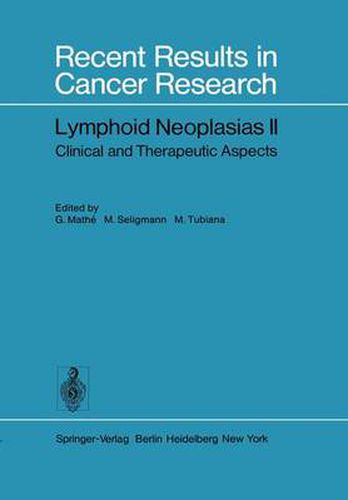Readings Newsletter
Become a Readings Member to make your shopping experience even easier.
Sign in or sign up for free!
You’re not far away from qualifying for FREE standard shipping within Australia
You’ve qualified for FREE standard shipping within Australia
The cart is loading…






This title is printed to order. This book may have been self-published. If so, we cannot guarantee the quality of the content. In the main most books will have gone through the editing process however some may not. We therefore suggest that you be aware of this before ordering this book. If in doubt check either the author or publisher’s details as we are unable to accept any returns unless they are faulty. Please contact us if you have any questions.
We have studied 24 cases of secondarily leukemic (stage V) lymphosarcoma (LS), 31 cases of d'emblee leukemic LS, and ten cases of lymphoid leukemic neoplasias transitional between d'emblee leukemic LS and chronic lymphocytic leukemia (eLL). These cases only concern the common types ofthe WHO classification ofLS, i.e., the prolymphocytic, the lymphoblastic, and the immunoblastic. Some cases have also been classified by cell surface markers. The secondarily leukemic conversion occurred in 40% of the lymphoblastic types, in 14% of the prolymphocytic types, and in 17% of the immunoblastic types. It never occurred at stage I but could occur after any other stage. The mediastinal involvement was observed in three types, but most often in the lymphoblastic type. The prognosis after an acute lymphoid leukemia (ALL) treatment comprising active immunotherapy following chemo(radio)therapy is better for the leukemic prolymphocytic and lymphoblastic LS than for the immunoblastic type. Two patients (one of the lymphoblastic type) are in complete remission after 8 and 5 years, respectively. We have described ten cases of d'emblee leukemic LS with either large lymphoid or extra lymphoid masses, bone marrow leukemic cell involvement, and LS aspects of neoplastic cells. Mediastinal, abdominal, or other tumor masses are frequent.
$9.00 standard shipping within Australia
FREE standard shipping within Australia for orders over $100.00
Express & International shipping calculated at checkout
This title is printed to order. This book may have been self-published. If so, we cannot guarantee the quality of the content. In the main most books will have gone through the editing process however some may not. We therefore suggest that you be aware of this before ordering this book. If in doubt check either the author or publisher’s details as we are unable to accept any returns unless they are faulty. Please contact us if you have any questions.
We have studied 24 cases of secondarily leukemic (stage V) lymphosarcoma (LS), 31 cases of d'emblee leukemic LS, and ten cases of lymphoid leukemic neoplasias transitional between d'emblee leukemic LS and chronic lymphocytic leukemia (eLL). These cases only concern the common types ofthe WHO classification ofLS, i.e., the prolymphocytic, the lymphoblastic, and the immunoblastic. Some cases have also been classified by cell surface markers. The secondarily leukemic conversion occurred in 40% of the lymphoblastic types, in 14% of the prolymphocytic types, and in 17% of the immunoblastic types. It never occurred at stage I but could occur after any other stage. The mediastinal involvement was observed in three types, but most often in the lymphoblastic type. The prognosis after an acute lymphoid leukemia (ALL) treatment comprising active immunotherapy following chemo(radio)therapy is better for the leukemic prolymphocytic and lymphoblastic LS than for the immunoblastic type. Two patients (one of the lymphoblastic type) are in complete remission after 8 and 5 years, respectively. We have described ten cases of d'emblee leukemic LS with either large lymphoid or extra lymphoid masses, bone marrow leukemic cell involvement, and LS aspects of neoplastic cells. Mediastinal, abdominal, or other tumor masses are frequent.